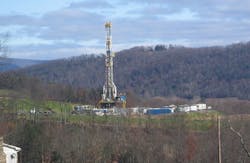Brine water that flows back from gas wells in the Marcellus Shale region after hydraulic fracturing is many times more salty than seawater, with high contents of various elements, including radium and barium. The chemistry is consistent with brines formed during the Paleozoic era, a study by an undergraduate student and two professors in Penn State’s Department of Geosciences found.
The study indicates that the brine flowback elements found in high levels in the late stages of hydraulic fracturing come from the ancient brines rather than from salts dissolved by the water and chemicals used as part of the fracking process. The paper by Lara O. Haluszczak, a Penn State student who has since graduated; professor emeritus Arthur W. Rose; and Lee R. Kump, professor and head of the Department of Geosciences; detailing those findings has been accepted for publication in Applied Geochemistry, the journal of the International Association of Geochemistry, and is available online.
For the study, the researchers analyzed data primarily from four sources: a report on brines from 40 conventional oil and gas wells in Pennsylvania; data on flowback waters from 22 Marcellus gas wells in Pennsylvania that the state Bureau of Oil and Gas Management had collected; flowback waters from two Marcellus gas wells from a previous study; and an industry study by the Marcellus Shale Coalition on flowback samples from eight horizontal wells that was reported in a Gas Technology Institute report.
Hydraulic fracturing, or fracking, is the process used to release natural gas from the shale formations deep underground. The process involves drilling down thousands of feet and, in the case of horizontal wells, sideways, then injecting a mixture of water, sand and chemicals to release the gas. The paper notes that about a quarter of the volume of fluid used for fracking returns to the surface but with the brine as a major component.
The paper looked at fluids that flowed back within 90 days of fracking. The samples analyzed in the study come from wells in Pennsylvania, along with two from northern Virginia.
The analysis shows that the brine flowback had extremely high salinity that does not match the chemical composition of the solution put into the wells during the fracking process. Instead, the elements being released are similar to those deposited during the Paleozoic era, hundreds of millions of years ago. Rose said the naturally occurring radioactive materials being brought to the surface after having been 8,000 feet deep were deposited with formations in that era.
Rose said while much attention has been focused on the chemicals that are injected into the shale formation during the fracking process, also of concern is the release of elements such as barium and radium that have been in the ground for millions of years. “Even if it’s diluted quite a bit, it’s still going to be above the drinking water limits,”he said. “There’s been very little research into this.”
Pennsylvania does have regulations on the disposal of fracking fluids. Rose said the findings highlight the importance of re-use and proper disposal of fracking fluids, including those from the later stages of drilling.
“Improper disposal of the flowback can lead to unsafe levels of these and other constituents in water, biota and sediment from wells and streams,” the researchers noted.
“The high salinity and toxicity of these waters must be a key criterion in the technology for disposal of both the flowback waters and the continuing outflow of the production waters,” the paper concluded.
